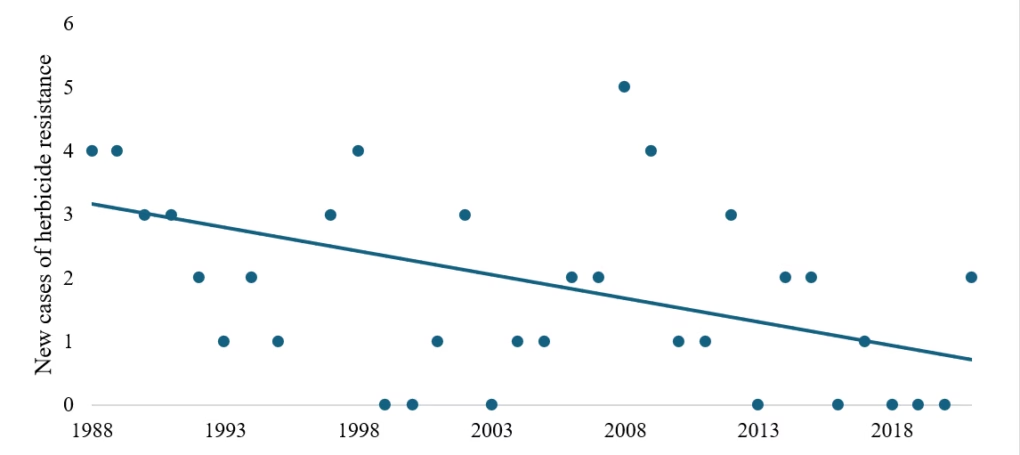Unwanted weeds within farmers’ fields is not a new problem, but it is still one of the greatest challenges farmers face on a yearly basis. If left uncontrolled, weeds can outcompete crops and lead to serious economic damage. This is why herbicides, agricultural chemicals that control weeds, are such important tools in farmers’ toolkits. Not only do they protect farmers’ crops from persistent weed pressure, but they also allow farmers to minimize or eliminate summerfallow and tillage as a form of weed control. Reductions in tillage and summerfallow practices have helped to reduce soil erosion and moisture losses and contribute to increasing levels of soil organic carbon. Combined with the use of genetically-modified herbicide-tolerant (GMHT) cropping systems, responsible herbicide use has become an important part of sustainable modern agricultural production.
Reliance on herbicides for weed control has led to concerns about increases in herbicide resistant (HR) weeds. Herbicide resistance in weeds dates back to the 1950s. The introduction of GMHT canola in 1995 heightened these concerns, especially over the challenge of controlling volunteer canola. However, Prairie agricultural practices, including crop rotations, input use, and weed control strategies, have evolved over the past 30 years. This blog examines the relationship between HR weed development, Prairie farm management practices, and the production of GMHT crops.
Development of HR Weeds
The Herbicide Resistance Action Committee’s International HR Weed Database documents cases of new HR weeds reported across the globe. This database was used to examine the development of HR weed cases on the Canadian Prairies over the past 35 years. A new resistance case was counted as any weed species displaying resistance to a herbicide mode of action (MOA), or combination of MOAs, that hadn’t been previously recorded in the province. Modes of action refer to the specific way a group of herbicides affects a susceptible plant. The first HR weed was reported on the Prairies in 1988. By 2021, 66 new cases of HR weeds had been reported in 21 different weed species. The top three weed species with the most reported resistance cases were wild oat with 14 cases followed by kochia and green foxtail, each with 14 cases. Four weed species (wild oat, kochia, green foxtail, and false cleavers) have developed resistance to multiple herbicide MOAs.
While increased herbicide use associated with zero-till systems and production of GMHT crops raised concerns over development of HR weeds, data from the International HR Weed Database indicates that the rate of newly reported HR weeds has not increased over the past 35 years. In fact, there has been a slight downward trend in the number of newly reported HR weed cases since 1988. Figure 1 illustrates how the annual number of new reports of HR weed species on the Prairies has exhibited a downward trend between 1988-2021. It is important to note that the reporting of weeds in this database does not include the increase in the spread of these HR weed species across the Prairies, only the number of species that have developed resistance to a herbicide MOA not yet reported provincially.
Simply examining the number of new HR cases, however, does not take into account the number of herbicide MOAs that weeds have formed resistance to. Some weed populations have developed resistance to multiple MOAs. When the number of resistant MOAs within each resistant weed population is counted, the total MOAs involved in new resistance cases across the Prairies between 1988-2021 is 88. This number includes 14 instances of multiple MOAs ranging from two to four resistant MOAs per weed.
Herbicides are broadly classified by their MOAs or the biological process by which they impact the plant. Sixty-eight percent of the MOAs that HR weeds have developed resistance to belong to two of the nine herbicide groups: Group 1 and Group 2. Group 1 and Group 2 herbicides are high-risk herbicides, which means that resistance is likely to occur after fewer applications than lower risk herbicide groups such as Group 9, which contains glyphosate. It is interesting to note that despite the concerns of glyphosate resistance developing in weeds after long-term production of GMHT crops, only 6% of resistant MOAs in Prairie weed species belong to Group 9 herbicides. This evidence contributes to refuting claims that weeds are rapidly developing resistance to glyphosate, a herbicide that continues to receive much criticism from activist groups.
Impact of Prairie Farm Practices
Over the past 30 years, Prairie farming practices have evolved to improve overall sustainability and efficiency. One of the most important things farmers have done is to expand and diversify their crop rotations. Not only do longer crop rotations help reduce the risk of disease and pest pressure in crops, but they also provide the opportunity for farmers to rotate the herbicides they apply to their fields to control weeds, as different crops have different herbicides best suited to their production. Results from our 2020 Crop Rotation Survey of Prairie farmers indicate that 30 years ago, between the crop production years of 1991-1994, only 30% of Prairie farmers were including a pulse crop in their rotations. By 2016-2019, 58% of farmers were including a pulse crop. Similarly, the number of Prairie farmers that planted three or more types of crops over the four-year period studied increased from 59% to 80% between 1991-1994 and 2016-2019.
In addition to diversifying their crop rotations, Prairie farmers have also made changes to the way they apply their herbicides to include more tank mixes and greater diversity in herbicide active ingredients. Chemical data from the Crop Rotation Survey was only available from Saskatchewan farmers. Between the crop production periods of 1991-1994 and 2016-2019, the average number of Saskatchewan farmers applying multiple active ingredients per herbicide application increased by 37% for pre-seed applications, 8% for in-crop applications, and 22% for post-harvest applications.
When Canadian Prairie farm management practices are compared to those of the most prominent agricultural regions of the United States (US), multiple differences can be noted. The most commonly practiced crop rotation in the major agricultural areas of the US is a 2-year rotation of corn-soybean. The average number of crop types planted within a rotation is 2.1, with about 60% of cropland planted to one or two crops. Typically, the simplest crop rotations are practiced in the most productive agricultural regions of the US. Perhaps unsurprisingly, the issue of HR weeds, especially glyphosate-resistant weeds, has posed a much greater challenge in the US than on the Canadian Prairies to date.
Conclusion
Herbicide resistant weeds present a challenge for farmers everywhere. Since the first discovery of a HR weed on the Prairies, populations of HR weeds have continued to increase. However, the rate at which new HR mechanisms are being reported in weed species is not expanding with the speed some predicted it would and is in fact showing a slight decline. Prairie farmers have diversified their crop management and weed control strategies to include longer and more diverse crop rotations, diversity of herbicide use, and appropriate tank mixes. All of these practices have contributed to the slower than expected rate of new HR weed discoveries.
This is not to say that the problem of resistant weeds is insignificant and will not become a more urgent problem in the future. This analysis only considers the first report of a resistance mechanism in a weed species and does not take into consideration the expansion of these resistant populations. Responsible and integrated approaches to weed management as well as continued investment into research and breeding programs to develop innovative tools and solutions to address the challenge of HR weed populations is important to ensure Canadian agriculture can remain competitive, efficient, and sustainable.
To check out the full article titled “Rate of Herbicide Resistant Weed Development: A Canadian Prairie Case Study”, click here





